











|
A new feature near the surface of the Sun, termed "solar moss" because its weird, sponge-like appearance resembles the plant, has been discovered by astronomers using NASA's Transition Region and Coronal Explorer (TRACE) spacecraft.
"With this discovery, we are beginning to resolve the Sun's mysterious transition region, a thin region in the solar atmosphere where the temperature soars from ten thousand to millions of degrees," said Dr. Thomas Berger of the Lockheed-Martin Solar and Astrophysics Lab (LMSAL), Palo Alto, Calif. "We are excited because this discovery offers us a new way to study the mass and energy flows in this region. It also helps us understand how the large magnetic loops in the Sun's outer atmosphere, the corona, form out of the highly intermittent magnetic fields on the Sun's surface. Studying the solar moss may ultimately shed light on the long-standing problem of how the corona is heated to million-degree temperatures."
Solar moss occurs at the base of certain coronal loops, immense magnetic arches of hot gas that are anchored in the Sun's visible surface and could span several dozen Earths laid end to end. It appears only below high pressure coronal loops in active regions, typically persisting for tens of hours, but has been seen to form rapidly and spread in association with loops that arise after a solar explosion, called a flare.
The moss consists of hot gas at about two million degrees Fahrenheit which emits extreme ultraviolet light observed by the TRACE instrument. It occurs in large patches, about 6,000 - 12,000 miles in extent, and appears between 1,000 - 1,500 miles above the Sun's visible surface, sometimes reaching more than 3,000 miles high. It looks "spongy" because the patches are composed of small bright elements interlaced with dark voids in the TRACE images. These voids are caused by jets of cooler gas from the Sun's lower atmosphere, the chromosphere, which is at about 10,000 degrees Fahrenheit. The bright moss elements move around and can vary in brightness over very short periods of time -- 30 seconds or less.
"The TRACE observations of solar moss show how the transition region is much more complex and dynamic than previously observed," said Dr. Bart De Pontieu of LMSAL. "We are getting a glimpse of how the Sun's magnetic field changes from a chaotic jumble at its visible surface to the well-organized magnetic field present in coronal loops. This transition is complicated by the presence of the dynamic and relatively cold jets from the chromosphere. These jets sometimes interact with and push around the much hotter plasma at the base of the coronal loops."
The coronal loops, at up to nine million degrees Fahrenheit, probably heat the moss by thermal conduction, similar to the way heat moves along an iron bar if one end is placed in a fire. However, there are indications that brief increases in brightness in the moss, corresponding to temporary million-degree temperature rises, may be due to input from local energy sources whose nature is unknown at present. The moss observations are thus helping to locate the as yet elusive energy source that is responsible for heating the Sun's outer atmosphere.
High resolution extreme ultraviolet images from TRACE allowed the solar moss to be observed for the first time, and the rapid cadence with which TRACE takes pictures provided unprecedented details about its behavior.
"However, the use of multiple instruments was key in determining the physical characteristics of the moss," according to Dr. Lyndsay Fletcher of LMSAL. "The Yohkoh/SXT telescope demonstrated the association of moss with the hotter coronal loops, and the Solar and Heliospheric Observatory CDS spectrometer allowed us to determine the moss temperature and density." Additionally, the extremely high resolution chromospheric imaging capability of the Swedish Vacuum Solar Telescope on the island of La Palma, Spain, led to the discovery that dark voids seen in the moss were actually cooler chromospheric gasses interacting with the moss.
TRACE is a NASA mission operated jointly by NASA's Goddard Space Flight Center, the Lockheed Martin Solar and Astrophysics Lab, the Smithsonian Astrophysical Observatory and Montana State University.
| Solar Moss Images |
|---|
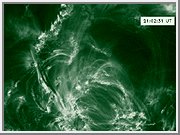 Solar Moss - 1 August 1999
Solar Moss - 1 August 1999
Solar moss consists of hot gas at about two million degrees Fahrenheit which emits extreme
ultraviolet light observed by the TRACE instrument. It occurs in large patches, about
6,000 - 12,000 miles in extent, and appears between 1,000 - 1,500 miles above the Sun's
visible surface, sometimes reaching more than 3,000 miles high. It looks
"spongy" because the patches are composed of small bright elements interlaced
with dark voids in the TRACE images. These voids are caused by jets of cooler gas from the
Sun's lower atmosphere, the chromosphere, which is at about 10,000 degrees Fahrenheit.
The solar moss appears only below high pressure coronal loops in active regions, typically
persisting for tens of hours, but has been seen to form rapidly and spread in association
with loops that arise after a solar explosion, called a flare.
(Courtesy NASA/GSFC)
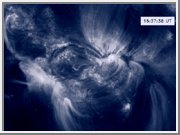 Solar Moss - 8 October 1999
Solar Moss - 8 October 1999
This image of the solar "moss" was taken by NASA's
Transition Region and Coronal Explorer (TRACE) spacecraft October 8, 1999. The image is
false color, looking almost directly down over coronal loops, immense magnetic arches of
hot gas that are anchored in the Sun's visible surface and could span dozens of Earths
laid end to end. The bases of the coronal loops appear as white, feathery objects in the
bottom left and top right of this image. The moss is the blue, black and white spongy
structure between the bases of the coronal loops.
(Courtesy NASA/GSFC)
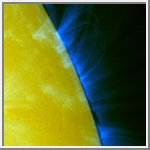 Moss at the Limb
Moss at the Limb
This composite TRACE image shows a layer of moss seen at the Solar
limb. The yellow image is a visible light image of the Sun and shows the "solar
surface" or photosphere. The blue image is a TRACE 171 Angstrom image showing 1 to 2
million degree coronal loops and a bright "layer" of moss just above the
surface. The moss layer is located between about 1500 to 4000 km (1000 - 2500 miles) above
the solar surface, much lower than the typical coronal loop apex heights.
(Courtesy NASA/GSFC)
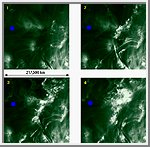 Moss Spreading
Moss Spreading
This sequence of 4 images shows the rapid formation and spreading of moss
following a minor flare event. The blue circle in each image shows the approximate
size of the Earth in the field-of-view.
The bright "front" of moss advancing across the image moves
with an average speed of about 17 km/sec (10 miles/sec or about 38,000 miles/hour).
The moss forms in response to the spreading of the flare heat in the hot coronal loops
above the moss; the loops are not visible in this TRACE 195 Angstrom image series because
they are so hot that they radiate in x-rays, which are invisible to the TRACE instrument.
(Courtesy NASA/GSFC)
 Moss at the Limb - High Resolution
Moss at the Limb - High Resolution
A shot of moss at the limb showing the "thin layer" effect as
well as many small, and one large, dark chromospheric jets projecting in front of the moss
layer.
(Courtesy NASA/GSFC)
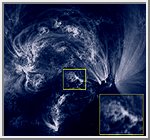 Solar Moss With Inset
Solar Moss With Inset
This image of the solar "moss" was taken by NASA's Transition Region and
Coronal Explorer (TRACE) spacecraft May 30, 1998. The image is false color, looking almost
directly down over coronal loops, immense magnetic arches of hot gas that are anchored in
the Sun's visible surface and could span dozens of Earths laid end to end. The bases of
the coronal loops appear as white, feathery objects on the right and left of this image.
The moss is the blue, black and white spongy structure between the bases of the coronal
loops.
The yellow box around one patch of moss is shown magnified by a factor of about 1.6 in the lower right corner. Note that moss at this scale is seen to be composed of bright patches approximately 1,250 - 2,500 miles (2,000 to 4,000 km) in size interspersed with dark holes, thus giving it its "spongy" or "mossy" appearance.
Solar moss consists of hot gas at about two million degrees Fahrenheit which emits extreme ultraviolet light observed by the TRACE instrument. It occurs in large patches, about 6,000 - 12,000 miles in extent, and appears between 1,000 - 1,500 miles above the Sun's visible surface, sometimes reaching more than 3,000 miles high. It looks "spongy" because the patches are composed of small bright elements interlaced with dark voids in the TRACE images. These voids are caused by jets of cooler gas from the Sun's lower atmosphere, the chromosphere, which is at about 10,000 degrees Fahrenheit.
The solar moss appears only below high pressure coronal loops in active regions,
typically persisting for tens of hours, but has been seen to form rapidly and spread in
association with loops that arise after a solar explosion, called a flare.
(Courtesy NASA/Tom Berger)
 Solar Moss
Solar Moss
This is the same as the above image but without the inset and yellow boxes.
(Courtesy NASA/Tom Berger)
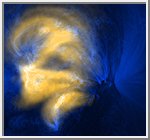 Solar Moss With Yohkoh Overlay
Solar Moss With Yohkoh Overlay
The same image as the above image but with the co-temporal Yohkoh Soft X-ray Telescope
image overlaid. Note that the patches of moss seen in the previous images
occur only beneath areas of high intensity soft x-ray emission as imaged by the SXT instrument.
(Courtesy NASA/GSFC)
Views of the Solar System Copyright © 1997-2000 by Calvin J. Hamilton. All rights reserved. Privacy Statement.